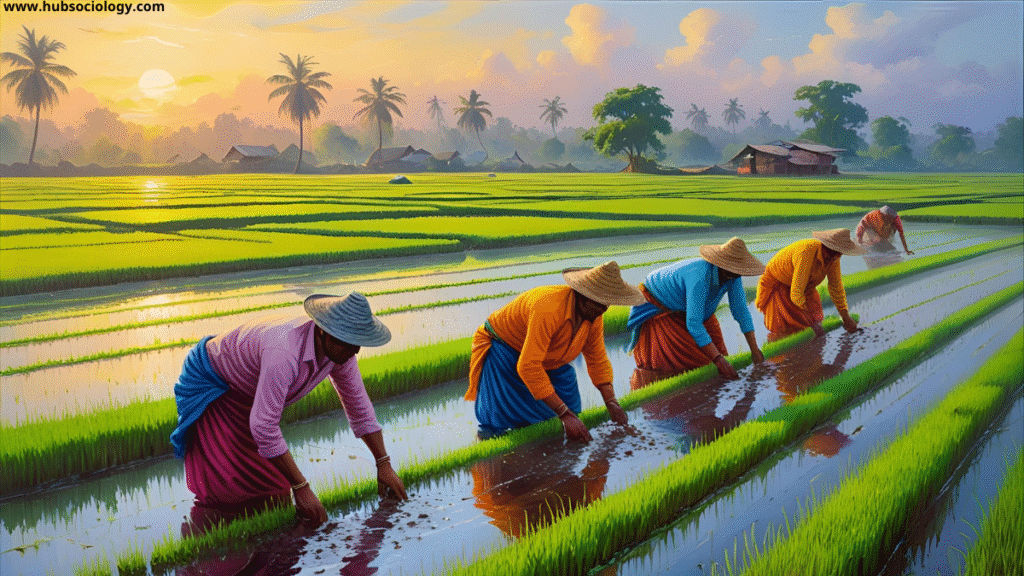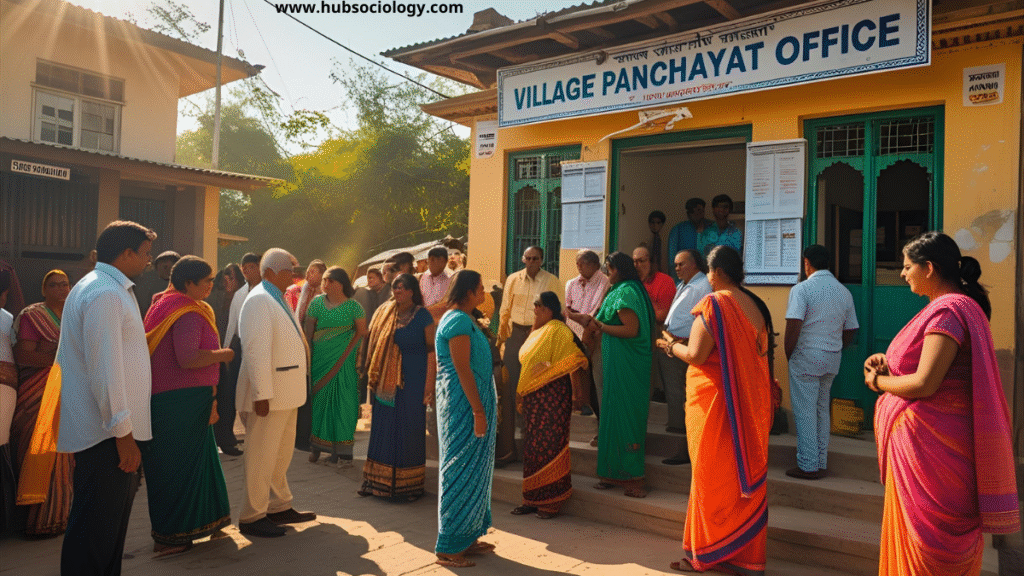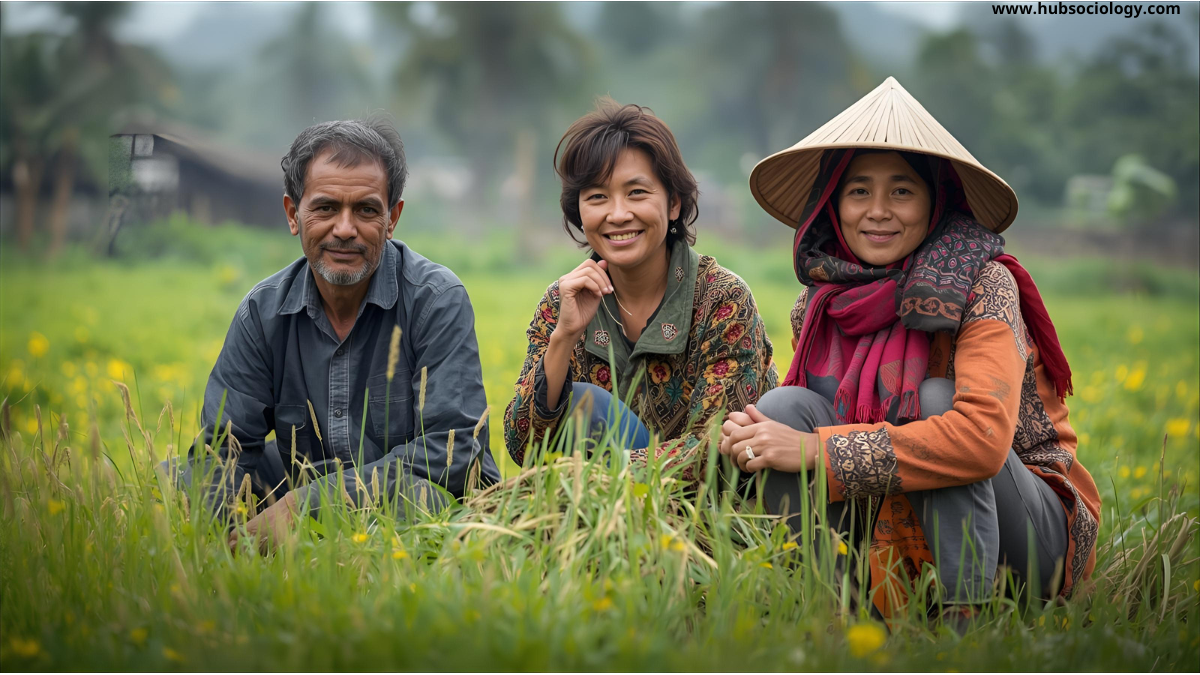Introduction on Characteristics of Indian Village Community
The Indian village community has always been the cornerstone of Indian civilization, culture, and social life. Nearly two-thirds of India’s population still resides in villages, making them an integral part of the country’s social structure. Sociologists such as M.N. Srinivas, A.R. Desai, and D.N. Majumdar have extensively studied rural life to understand its nature, organization, and dynamics. A village is not merely a physical settlement of houses and farms; it is a social system where people live in close contact, sharing traditions, customs, and values.
This article explores the characteristics of Indian village communities from a sociological perspective, highlighting their social organization, cultural patterns, and the ongoing processes of change.

Table of Contents
1. Small Size and Close-Knit Social Relations
One of the most significant characteristics of the Indian village community is its small size and close interpersonal relationships. Villages usually have a smaller population compared to urban areas, which fosters familiarity and intimacy among residents. Social interactions are face-to-face, and people know each other personally. The small size leads to a strong sense of belonging and social solidarity, as described by Émile Durkheim in his concept of mechanical solidarity—a social cohesion based on shared values and traditions.
In this environment, social control is largely informal, based on customs and community opinion rather than formal laws. The village community operates like a large family, where mutual help, cooperation, and collective decision-making are common.
2. Agriculture-Based Economy
The Indian village community is predominantly agrarian. Agriculture and allied activities like animal husbandry, fishing, and handicrafts form the primary source of livelihood. Land is the main economic resource and symbol of status and power. The rhythm of rural life revolves around the agricultural cycle—sowing, harvesting, and festivals linked to seasons.
This dependence on nature shapes social and cultural practices. For example, festivals such as Pongal, Baisakhi, and Onam celebrate harvest seasons. However, the reliance on monsoons also makes the rural economy vulnerable to environmental fluctuations, leading to issues like poverty and migration.
3. Joint Family System and Kinship Ties
Kinship and family play a central role in rural society. The joint family system—where multiple generations live together under one roof—is a traditional feature of Indian villages. Family is both a social and economic unit that provides emotional security and labor support. Kinship ties extend beyond the household, influencing marriage alliances, caste relations, and social networks.

In sociological terms, the kinship structure reinforces social cohesion and collective identity. Marriage is generally endogamous within caste and exogamous within the gotra or clan. The village kinship system serves as a mechanism of mutual support and social control.
4. Caste System and Social Stratification
The caste system has historically shaped the structure of Indian village communities. Each village comprises several castes, often living in separate quarters or hamlets (locally called paras or tolas). Traditionally, these castes are arranged in a hierarchical order—with upper castes controlling land and resources, and lower castes providing labor and services.
The village operates as a system of interdependence, known as the Jajmani system, where different castes perform hereditary occupations and exchange goods and services. For example, the potter makes earthenware, the blacksmith repairs tools, and the barber serves the community, all in exchange for grains or other necessities.
Though modern influences, education, and legal reforms have weakened the rigidity of the caste system, its social imprint remains visible in patterns of occupation, marriage, and social interaction.
5. Panchayat System and Local Governance
The village panchayat is a key institution in rural India, serving as the foundation of local self-governance. Traditionally, the panchayat consisted of elders who resolved disputes and maintained order based on customs and moral codes. This reflects the village’s autonomous character and self-regulatory nature.
After independence, the Panchayati Raj System was institutionalized to promote democratic participation at the grassroots level. Sociologically, the panchayat serves as both a political and social institution, mediating between traditional authority and modern democracy. It reflects the integration of traditional community life with modern state structures.

6. Simple and Traditional Way of Life
Indian village communities are characterized by simplicity, traditionalism, and conservatism. People often follow age-old customs, rituals, and festivals with deep religious and cultural significance. Social change occurs slowly, as villagers tend to value continuity and stability over innovation.
Sociologists call this a “little tradition”—a concept introduced by Robert Redfield and M.N. Srinivas—to describe localized cultural systems that coexist with the “great tradition” of Sanskritic or national culture. The little tradition reflects folk beliefs, oral traditions, and practices that maintain the village’s unique identity.
7. Community Feeling and Collective Life
A strong sense of community or collective consciousness is a defining feature of Indian villages. The villagers participate collectively in social ceremonies, religious festivals, and agricultural activities. This cooperation is visible in practices such as mutual labor exchange during harvest and collective celebrations of local deities.
The spirit of cooperation strengthens social bonds and ensures survival during crises like droughts or crop failures. Such communal life reinforces Durkheim’s notion that social solidarity emerges from shared experiences and collective practices.
8. Role of Religion and Rituals
Religion permeates every aspect of village life. Temples, shrines, and sacred groves often occupy central places in villages. Local deities, ancestor worship, and agricultural rituals reflect the villagers’ spiritual connection with nature and the divine. Religious leaders or priests often play influential roles in maintaining moral order.
These practices are not only religious but also sociological, as they strengthen community cohesion and regulate behavior. Rituals such as marriages, harvest festivals, and fairs serve as social gatherings that reinforce unity.
9. Dependence on Nature and Environment
The Indian village community lives in close harmony with nature. Rivers, forests, and farmlands are integral to their daily life and livelihood. Traditional knowledge of seasons, soil, and climate is passed down generations. Environmental factors determine the economic and social rhythms of rural life.
However, modernization, deforestation, and urban encroachment are disrupting this balance. Environmental sociology examines how ecological changes impact rural communities, leading to issues such as displacement, livelihood loss, and cultural erosion.
10. Social Change and Modernization
While tradition remains strong, Indian villages are undergoing rapid transformation due to industrialization, urbanization, education, and communication. Migration to cities for employment, the spread of mobile technology, and government welfare programs are reshaping the social fabric of villages.
Sociologists like M.N. Srinivas describe this process as “Sanskritization” and “Westernization”—where lower castes adopt upper-caste lifestyles and where rural people absorb modern values and practices. The result is a hybrid social structure combining tradition with modernity.
Conclusion on Characteristics of Indian Village Community
The Indian village community represents both continuity and change—rooted in ancient traditions yet dynamically adapting to modernization. From a sociological standpoint, it embodies the essence of collective living, interdependence, and cultural richness, while also facing challenges such as inequality, poverty, and ecological degradation. Understanding its characteristics is crucial for policymakers, sociologists, and educators who aim to build inclusive rural development models.
The village is not just a geographical unit but a symbol of India’s social diversity and resilience. As Mahatma Gandhi rightly said, “India lives in her villages,” and understanding their sociological characteristics is key to understanding the soul of the nation.
Do you like this this Article ? You Can follow as on :-
Facebook – https://www.facebook.com/hubsociology
Whatsapp Channel – https://whatsapp.com/channel/0029Vb6D8vGKWEKpJpu5QP0O
Gmail – hubsociology@gmail.com
Topic-Related Questions on Characteristics of Indian Village Community
5 Marks on Characteristics of Indian Village Community
- What is meant by the village community in India?
- Explain the importance of kinship ties in Indian villages.
- Mention any two features of the Indian village economy.
10 Marks on Characteristics of Indian Village Community
- Discuss the role of caste system in structuring Indian village life.
- Describe the nature of social solidarity in rural communities.
15 Marks on Characteristics of Indian Village Community
- Examine the major characteristics of Indian village communities from a sociological perspective.
- Analyze the changes occurring in Indian village society due to modernization and urban influence.

1 thought on “Characteristics of Indian Village Community: A Sociological Perspective”